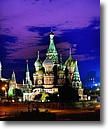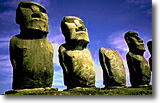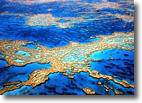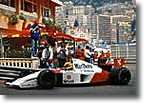| These are some of the places that remain on my travel journal's "to do" list, a collection
of remarkable sights I am still driven to observe, and someday
may be privileged to witness in person.
|
 Machu Picchu, high in the Andes Mountains of modern Peru, was constructed between
1460 and 1470 by Pachacuti Yupanqui, an Incan ruler. This
ancient city lies at an altitude of 8,000 feet, well above
the Urubamba River canyon cloud forest. The granite blocks making
up
this the ruins of the
city fit together perfectly without mortar, although none of the
blocks are the same size and have many faces; some have as many
as 30 corners. The joints are so tight that even the thinnest of
knife blades can't be forced between the stones. Worshipers of
a sun god, the inhabitants of Machu Picchu developed the modern
calendar, dividing the year into 365 days, 52 weeks, 12 months,
the months into days, the days into 24 hours, and the hours into
60 minutes, exactly as we
know it today. Machu Picchu, high in the Andes Mountains of modern Peru, was constructed between
1460 and 1470 by Pachacuti Yupanqui, an Incan ruler. This
ancient city lies at an altitude of 8,000 feet, well above
the Urubamba River canyon cloud forest. The granite blocks making
up
this the ruins of the
city fit together perfectly without mortar, although none of the
blocks are the same size and have many faces; some have as many
as 30 corners. The joints are so tight that even the thinnest of
knife blades can't be forced between the stones. Worshipers of
a sun god, the inhabitants of Machu Picchu developed the modern
calendar, dividing the year into 365 days, 52 weeks, 12 months,
the months into days, the days into 24 hours, and the hours into
60 minutes, exactly as we
know it today.
 Saint Basil's Cathedral rises from Moscow's Red Square in an irresistible profusion
of colors and shapes. Its montage of domes, cupolas, arches, towers
and
spires,
each
bearing a distinctive pattern and hue, have fascinated the eyes
of visitors since its construction in the 1550s. Although St. Basil's
was built to commemorate Ivan the Terrible's capture of the Mongol
stronghold of Kazan and is properly named Cathedral of the Intercession,
its popular name has long associated it with a ragged prophet who
foretold the Moscow fire of 1547. Red Square is indelibly associated
with images of stonefaced Soviet leaders standing in the bitter
cold as a panoply of military might rumbles past Lenin's Mausoleum.
Although the Square is no longer witness to the imposing Soviet
parades of May Day, it remains
a profoundly impressive space. Saint Basil's Cathedral rises from Moscow's Red Square in an irresistible profusion
of colors and shapes. Its montage of domes, cupolas, arches, towers
and
spires,
each
bearing a distinctive pattern and hue, have fascinated the eyes
of visitors since its construction in the 1550s. Although St. Basil's
was built to commemorate Ivan the Terrible's capture of the Mongol
stronghold of Kazan and is properly named Cathedral of the Intercession,
its popular name has long associated it with a ragged prophet who
foretold the Moscow fire of 1547. Red Square is indelibly associated
with images of stonefaced Soviet leaders standing in the bitter
cold as a panoply of military might rumbles past Lenin's Mausoleum.
Although the Square is no longer witness to the imposing Soviet
parades of May Day, it remains
a profoundly impressive space.

Easter Island is over 2,000 miles from the nearest population centers (Tahiti
and Chile), making it one of the most isolated places on Earth.
A triangle of volcanic rock in the South Pacific, it is best
known for the giant stone monoliths, known as Moai, that dot the
coastline. The early settlers called the island "Te Pito O Te Henua" (Navel of the World). Admiral Roggeveen, who came upon the island on Easter
Day in 1722, named it Easter Island. Erich Von Daniken, in his
book
Chariots of the Gods, theorized that the Earth was visited by extra-terrestrials
some 10,000 to 40,000 years ago, building inexplicable monuments
like Easter Island using now-lost technologies far more advanced
than the primitive pre-historic civilizations around which they
arose. Traditional science regards Von Danikenn with disdain,
but I for one remain skeptical.
 The Great Barrier Reef lines the coast of northeastern Australia, extending some
2,000 km, and is home to the world's largest concentration of coral
reefs, with 400 types of coral, 1,500 species
of fish and 4,000 types of mollusc. The reef is a place of remarkable
variety and beauty, regarded as the most spectacular marine scenery
on Earth, But is also one of he more endangered habitats in the
world, suffering from severe mass coral bleaching — a result of elevated sea temperatures — in 1998 and again in 2002. I sure would like to visit before it is lost forever. The Great Barrier Reef lines the coast of northeastern Australia, extending some
2,000 km, and is home to the world's largest concentration of coral
reefs, with 400 types of coral, 1,500 species
of fish and 4,000 types of mollusc. The reef is a place of remarkable
variety and beauty, regarded as the most spectacular marine scenery
on Earth, But is also one of he more endangered habitats in the
world, suffering from severe mass coral bleaching — a result of elevated sea temperatures — in 1998 and again in 2002. I sure would like to visit before it is lost forever.
One of my lasting passions is Grand Prix motor racing. The oldest and best-known
auto race in the Formula One series is run every May through the
tight urban streets of the small principality of Monaco.  While
the circuit itself has changed little over the years, the sight
of 750-horsepower F1 machines screaming around Ste. Devote and
through Casino Square is the ultimate in F1 excitement. I have
been to
grands prix in the United States (Watkins Glen, Long Beach and
Las Vegas) and twice in Canada, but have not yet managed to make
it
to the Monaco Grand Prix. Someday I certainly will. While
the circuit itself has changed little over the years, the sight
of 750-horsepower F1 machines screaming around Ste. Devote and
through Casino Square is the ultimate in F1 excitement. I have
been to
grands prix in the United States (Watkins Glen, Long Beach and
Las Vegas) and twice in Canada, but have not yet managed to make
it
to the Monaco Grand Prix. Someday I certainly will.
|
 Machu Picchu, high in the Andes Mountains of modern Peru, was constructed between
1460 and 1470 by Pachacuti Yupanqui, an Incan ruler. This
ancient city lies at an altitude of 8,000 feet, well above
the Urubamba River canyon cloud forest. The granite blocks making
up
this the ruins of the
city fit together perfectly without mortar, although none of the
blocks are the same size and have many faces; some have as many
as 30 corners. The joints are so tight that even the thinnest of
knife blades can't be forced between the stones. Worshipers of
a sun god, the inhabitants of Machu Picchu developed the modern
calendar, dividing the year into 365 days, 52 weeks, 12 months,
the months into days, the days into 24 hours, and the hours into
60 minutes, exactly as we
know it today.
Machu Picchu, high in the Andes Mountains of modern Peru, was constructed between
1460 and 1470 by Pachacuti Yupanqui, an Incan ruler. This
ancient city lies at an altitude of 8,000 feet, well above
the Urubamba River canyon cloud forest. The granite blocks making
up
this the ruins of the
city fit together perfectly without mortar, although none of the
blocks are the same size and have many faces; some have as many
as 30 corners. The joints are so tight that even the thinnest of
knife blades can't be forced between the stones. Worshipers of
a sun god, the inhabitants of Machu Picchu developed the modern
calendar, dividing the year into 365 days, 52 weeks, 12 months,
the months into days, the days into 24 hours, and the hours into
60 minutes, exactly as we
know it today. Saint Basil's Cathedral rises from Moscow's Red Square in an irresistible profusion
of colors and shapes. Its montage of domes, cupolas, arches, towers
and
spires,
each
bearing a distinctive pattern and hue, have fascinated the eyes
of visitors since its construction in the 1550s. Although St. Basil's
was built to commemorate Ivan the Terrible's capture of the Mongol
stronghold of Kazan and is properly named Cathedral of the Intercession,
its popular name has long associated it with a ragged prophet who
foretold the Moscow fire of 1547. Red Square is indelibly associated
with images of stonefaced Soviet leaders standing in the bitter
cold as a panoply of military might rumbles past Lenin's Mausoleum.
Although the Square is no longer witness to the imposing Soviet
parades of May Day, it remains
a profoundly impressive space.
Saint Basil's Cathedral rises from Moscow's Red Square in an irresistible profusion
of colors and shapes. Its montage of domes, cupolas, arches, towers
and
spires,
each
bearing a distinctive pattern and hue, have fascinated the eyes
of visitors since its construction in the 1550s. Although St. Basil's
was built to commemorate Ivan the Terrible's capture of the Mongol
stronghold of Kazan and is properly named Cathedral of the Intercession,
its popular name has long associated it with a ragged prophet who
foretold the Moscow fire of 1547. Red Square is indelibly associated
with images of stonefaced Soviet leaders standing in the bitter
cold as a panoply of military might rumbles past Lenin's Mausoleum.
Although the Square is no longer witness to the imposing Soviet
parades of May Day, it remains
a profoundly impressive space.
 The Great Barrier Reef lines the coast of northeastern Australia, extending some
2,000 km, and is home to the world's largest concentration of coral
reefs, with 400 types of coral, 1,500 species
of fish and 4,000 types of mollusc. The reef is a place of remarkable
variety and beauty, regarded as the most spectacular marine scenery
on Earth, But is also one of he more endangered habitats in the
world, suffering from severe mass coral bleaching — a result of elevated sea temperatures — in 1998 and again in 2002. I sure would like to visit before it is lost forever.
The Great Barrier Reef lines the coast of northeastern Australia, extending some
2,000 km, and is home to the world's largest concentration of coral
reefs, with 400 types of coral, 1,500 species
of fish and 4,000 types of mollusc. The reef is a place of remarkable
variety and beauty, regarded as the most spectacular marine scenery
on Earth, But is also one of he more endangered habitats in the
world, suffering from severe mass coral bleaching — a result of elevated sea temperatures — in 1998 and again in 2002. I sure would like to visit before it is lost forever. While
the circuit itself has changed little over the years, the sight
of 750-horsepower F1 machines screaming around Ste. Devote and
through Casino Square is the ultimate in F1 excitement. I have
been to
grands prix in the United States (Watkins Glen, Long Beach and
Las Vegas) and twice in Canada, but have not yet managed to make
it
to the Monaco Grand Prix. Someday I certainly will.
While
the circuit itself has changed little over the years, the sight
of 750-horsepower F1 machines screaming around Ste. Devote and
through Casino Square is the ultimate in F1 excitement. I have
been to
grands prix in the United States (Watkins Glen, Long Beach and
Las Vegas) and twice in Canada, but have not yet managed to make
it
to the Monaco Grand Prix. Someday I certainly will.